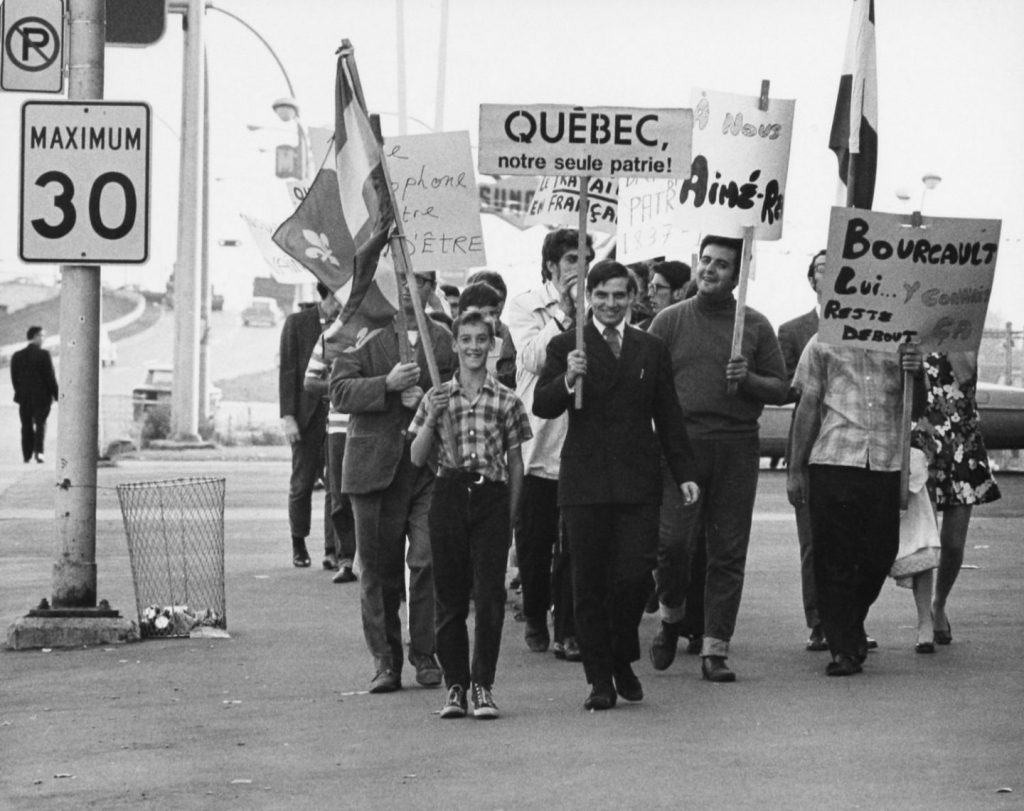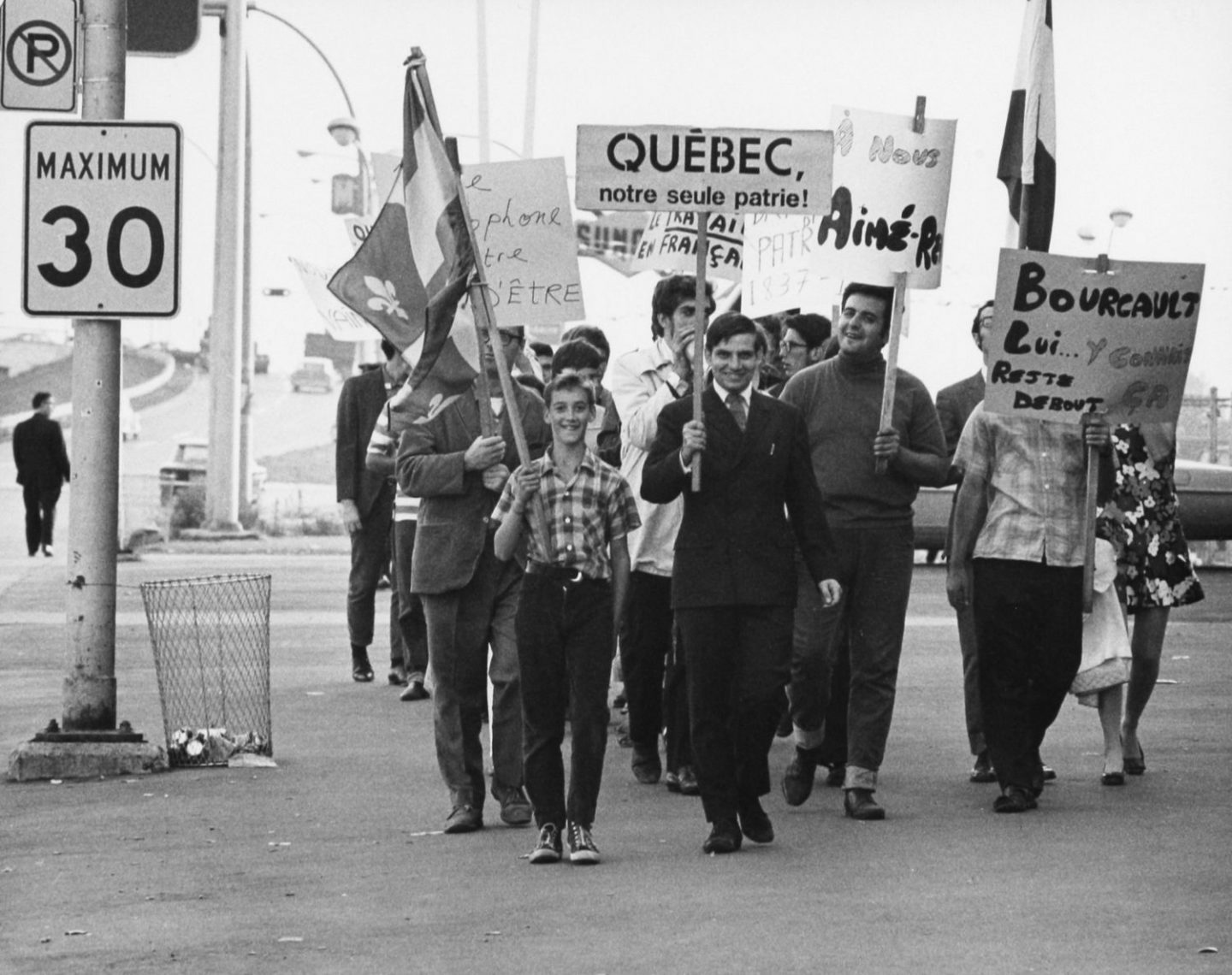The Canadian Encyclopedia – The Saint-Léonard Schools Crisis is the name of a two-year period of low-intensity civil unrest in the Montreal suburb of Saint-Léonard in the mid-late 1960s. In the context of the Quiet Revolution, the crisis focused on whether allophone immigrants had the right to choose their children’s language of instruction. Though there were angry, occasionally violent protests, the matter was resolved peacefully through legislation and a public commission. The crisis ultimately led to the adoption of language laws in Quebec that made French the province’s sole official language, as well as the primary language of instruction for immigrants to the province.
Historical Context
In the 1950s and 1960s, Italian immigrants settled in Saint-Léonard. At the time, the area was quickly changing from being rural and francophone to being suburban and increasingly multilingual. From a population of 925 in 1956, Saint-Léonard’s population grew to 52,000 in 1971.
Many of these Italian immigrants wanted to send their children to English-language schools. They believed that learning English would give their children more opportunities as the anglophone upper class dominated Quebec’s economy. In contrast, francophone schools focused more on preserving traditions. Moreover, francophone spaces were less welcoming of new immigrants. The Parent Report argued that this was because previous generations of French Canadians lived in relative cultural isolation and were heavily focused on preserving their language and society. As francophone birthrates slowed and many immigrants learned English instead of French, immigration came to be seen as a potential threat to Quebec’s francophone society.

(photo by Antoine Desilets/courtesy of the Bibliothèque et Archives nationales du Québec/611983/CC BY-NC-ND 4.0)
Linguistic Tensions
While non-francophones settled Saint-Léonard, the area also saw an influx of middle-class francophones, many of whom had been active in Quebec nationalist groups in their youth. (See Francophone Nationalism in Quebec.) Saint-Léonard’s francophone community, which had been the majority a decade earlier, was now just over half of the population.
The Italian community’s presence led to the creation of English-language classes offered by French schools. A bilingual program (French and English) was introduced for grades 1 to 3 in 1963, but by 1967 parents were becoming discouraged with it, as it was not creating bilingual students.
The bilingual program was supposed to help Italians integrate into the French-speaking majority. However, the program taught mathematics and science in English, encouraging students to pursue high school education in English. By 1968, about 85 per cent of bilingual program graduates opted to attend high school in English.
School commissioners proposed the gradual elimination of the bilingual program in favour of unilingual French education for the first three years, with English taught as a second language. This proposal was opposed by immigrant communities. In February 1968, they organized to get the right to choose the language of instruction for their children.
Meanwhile, in March 1968, those in favour of unilingual French-language education created the Mouvement pour l’intégration scolaire (MIS), which became the Ligue pour l’intégration scolaire (LIS). The MIS wanted to reverse the trend of new immigrants integrating into the English-speaking provincial minority. Saint-Léonard architect Raymond Lemieux was elected the MIS’s first leader. Both sides contested the school board elections to contest the language of education issue.
Saint-Léonard Crisis
In May 1968, the MIS won a majority of seats on the school board. Its position was that the language of instruction in the community would only be French, beginning in September of that year. Parents in the Italian Canadian community reacted by creating underground schools in their homes. A proposed compromise — the conversion of a French high school into a school for the English-speaking community ― led French students to occupy it for several days. Days later, the school board reversed its decision. On the first day of school in September 1968, an estimated 1,700 English-speaking schoolchildren were kept home in an act of protest. The issue rapidly became a matter of national concern. On 11 September 1968, Prime Minister Pierre Trudeau agreed to meet with the protesters, who by this point were organizing marches to Ottawa, as well as boycotts.
Riots of September 1969
Neither the government, the school boards, nor the parents’ groups had come to any solution by the beginning of the new school year in September of 1969. A compromise, wherein the Italian community would create a partly government-subsidized private school for English-language education, left both parties dissatisfied. On 3 September 1969, Raymond Lemieux organized a public meeting with LIS at a high school near Saint-Léonard. A group of Italian parents attended, and the meeting degenerated into confrontation and violence, which required police intervention. Another demonstration, this time a LIS march through the heart of Saint-Léonard, took place on 10 September 1969; this also turned violent, resulting in property damage, arrests and injuries. The La Presse newspaper estimated that around 2,500 joined the march.
In response, Quebec premier Jean-Jacques Bertrand commissioned an inquiry into the French language in Quebec and language rights in general. The commission was chaired by linguist Jean-Denis Gendron, and known as the Gendron Commission. It released its findings in 1973, paving the way for Quebec’s language policy.
Because of the violent demonstrations in Saint-Léonard, Bertrand was forced to act before the commission delivered its final report. In November 1969, his government passed Bill 63, a compromise aimed to please both sides.
Bill 63
Bill 63 was the first Quebec government bill that sought to promote the use of the French language. It aimed to encourage French-language instruction in Quebec’s public schools. It insisted that students enrolled in anglophone institutions acquire a working knowledge of French. However, Quebec nationalists considered Bill 63 to be too weak to preserve the viability of the French language. They wanted to force immigrants to send their children to francophone schools. In 1974, Bill 63 was repealed and replaced by Bill 22, which was partly based on the recommendations of the Gendron Commission.
Legacy
Bill 63’s shortcomings led to stricter language laws, such as Bill 22, in 1974, and then Bill 101 in 1977. The latter made French the only language of instruction for all new immigrants to Quebec. An important political effect of the Saint-Léonard Schools Crisis was the demise of the Union Nationale party. The party had dominated Quebec politics throughout much of the period before the Quiet Revolution. The Union Nationale never recovered from its poor handling of the crisis.
Saint-Léonard continues to have a large Italian Canadian population and is home to several of Montreal’s major Italian Canadian cultural institutions. French is the home language of about 44 per cent of the local population while English is the home language of about 22 per cent of the population. Other languages represent 34 per cent of those spoken in Saint Leonard, which is today a borough of the city of Montreal.


